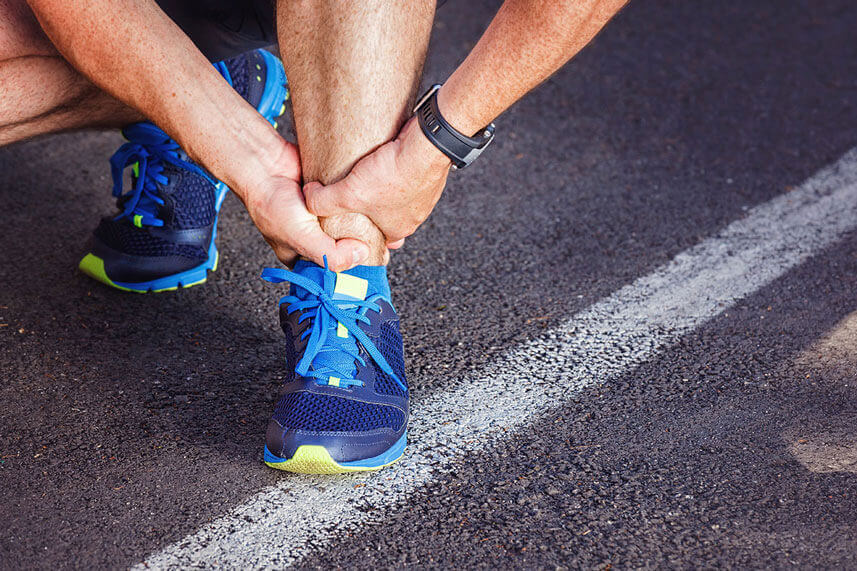Sprains & strains
What is a sprain?
Sprains are one of the most common injuries treated by FastMed. They can have many causes, but usually result from a twist, fall, or sudden jolt to a joint, which damages the ligament—the tissue that holds two joints together. It is important to have your injury properly examined by the FastMed professionals to rule out other possible injuries, and to determine your best course of treatment.
Signs of a sprain
If a sprained ankle, knee, foot, arm, or other joint is suspected, your FastMed provider will check the area for bruising, swelling, pain, and stiffness. Your symptoms will determine the sprain grade.

Sprain grades
Sprains are graded by the severity of the symptoms:
Grade I: This least-serious sprain grade involves some stretching and tearing of the ligament, with mild tenderness, stiffness, and swelling. Joint movement may cause only minor pain.
Grade II: Grade II sprains involve an incomplete tearing of the ligament. Pain and swelling will be moderate, and use of the joint may be painful.
Grade III: Grade III sprains result from a complete tear in one or more ligaments. Bruising and swelling can be severe, and use of the joint will be nearly impossible. The joint may also feel wobbly.
How to treat a sprain
Treatment for sprains and strains is essentially the same. Your FastMed provider may recommend:
- Resting the injured area
- Elevating the joint, such as placing a sprained arm or ankle on a pillow
- Applying ice with a barrier cloth, 4 to 8 times per day
- Use of specially designed compression bandages
- Medication for pain & swelling
- Use of a cane or crutches during sprained foot, knee, or ankle treatment
Common types of sprains
Whether you show symptoms of a sprained ankle, sprained arm, sprained foot, sprained wrist, or muscle sprain (actually a strained muscle), the FastMed team will provide the care you need for a quick recovery—and without the long wait or expense of an ER visit.
Learn more about sprained ankle symptoms, treatment, and recovery.
Strains
Strains involve muscles and tendons, as opposed to ligaments. Treatment is the same. See the sprain treatment section.
Broken bones
What is a fracture?
A fracture is simply a medical term for a broken bone. FastMed offers urgent care services for both adult and pediatric fractures. Whether your broken bone results from a sports injury or a slip in the shower, it is important to seek medical attention to ensure proper healing.
The FastMed medical staff can determine the severity of your injury and offer the appropriate treatment without the long wait and expense of visiting an ER. In fact, some FastMed locations have sports medicine specialists on staff, and all locations provide splinting services.
Types of fractures
Your FastMed provider will examine the area and review the X-rays. If a bone is broken, the provider will evaluate the type of fracture and recommend appropriate care and treatment.
Although most people refer to broken bones by their placement—such as a broken hand, broken wrist, broken heel, or broken femur—there are also different types of fractures. Your FastMed provider may specify a broken bone as displaced or non-displaced, or open or closed.
Displaced fractures result when bones break, and the pieces no longer line up. When a bone breaks into multiple pieces, it is considered a comminuted fracture. An open fracture is also called a compound fracture. This means that the bone is visible through the skin, and carries an increased risk of infection. Additional treatment is necessary to limit this risk.
How to tell if a bone is broken
Your FastMed provider will look for the following fracture symptoms:
- Resting the injured area
- Elevating the joint, such as placing a sprained arm or ankle on a pillow
- Applying ice with a barrier cloth, 4 to 8 times per day
- Use of specially designed compression bandages
- Medication for pain & swelling
- Use of a cane or crutches during the sprained foot, knee, or ankle treatment
How do broken bones heal?
To ensure faster bone healing, your FastMed provider will categorize the fracture by type and recommend the appropriate treatment. Proper bone healing requires immobilization of the affected area. In most cases, this will mean wearing a cast, sling, splint, and/or brace.
In extreme cases, fracture treatment may include surgery. Rehabilitation or physical therapy may also be recommended while broken bones are healing, to maintain strength and flexibility in surrounding muscle tissue.
How long does it take for a broken bone to heal?
Once a fracture is properly realigned and immobilized, the body takes over. New cells form, and the old bone tissue is replaced by new, usually within six to eight weeks. In some cases, however, bone healing may take several months.
It is essential to have a broken bone properly examined and diagnosed by FastMed professionals. We will help your fracture heal smoothly.
* The content presented on this page is not intended to diagnose health problems or take the place of professional medical care.